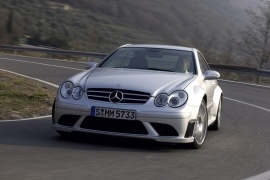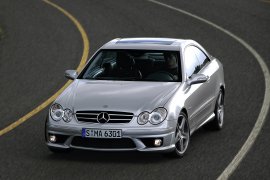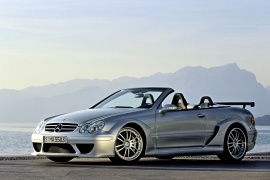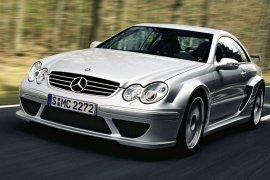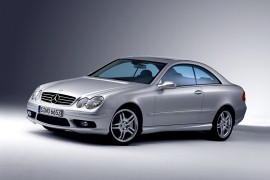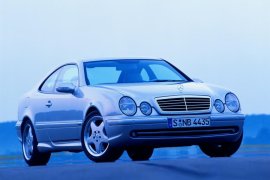MERCEDES BENZ CLK AMG Models/Series Timeline, Specifications & Photos
First production year: 1999
Engines: Gasoline
Body style: Coupé (two-door)
Mercedes-Benz introduced the CLK 63 AMG Black Series in 2007 as its wildest, hottest, fastest car in the lineup, with performances that could match a supercar.
The German carmaker had a long history in motorsport, and its involvement in Formula 1 and other GT races gave them the know-how for a high-performance vehicle. In 2006, Mercedes-Benz refreshed the CLK range and offered it an AMG 63 version, but that was not enough. An then, in 2007, it introduced the Black Series version.
The 63 AMG Black Series had to show its muscles, and the R&D team mixed the aerodynamic needs with the design. The result was a fierce-looking car with a broad, trapezoidal grille on the front apron flanked by two side-scoops to cool the brakes. Its flared wheel arches, both front and rear, were needed to cover the wide tires, and a set o side sills connected them to form an efficient aerodynamic shape. At the back, AMG installed a lip spoiler on the trunk lid. That was proof that it didn't want to go as extreme as the 2004 CLK DTM version.
Inside, the carmaker deleted the rear bench and placed carbon-fiber trims on the center stack, the center console, and the door panels. Its sport-bucket seats with high bolstering sported the AMG logo on their integrated headrests. The driver could have controlled the seven-speed automatic gearbox via two paddle-shifters placed behind the steering wheel. AMG didn't forget that it had to be a CLK at the end of the day and offered an adequate comfort level. It added a regular sound system, a dual-zone climate control, and an ashtray for the smoke after.
Under the hood, AMG installed a 6.2-liter engine paired to a seven-speed automatic gearbox (AMG Speedshift) which sent the power to the rear wheels via a limited-slip differential.
MERCEDES BENZ CLK 63 AMG Black Series (C209) 6.2 V8 7AT (507 HP)
Installing a big V-8 engine in a car designed to accommodate a V-6 was never easy, but AMG did it, and it did it right.
Mercedes-Benz built the CLK on the same old platform used for the C-Class since 2000. It was reliable and tough enough to hold more powerful engines, and the carmaker knew that. Later on, it added V-8 engines, but AMG went over the fence and stuck inside its 6.2-liter engine, developing it from scratch.
AMG didn't want to go too subtle with the CLK63. It wasn't that kind of car where just a set of wheels and some lip-spoilers could do the job, so it installed a completely different exterior package. At the front, the A-shaped lower grille on the bumper was unique for that version. In the side-scoops, it installed fog lights with chromed surroundings. From its sides, the car sported aerodynamic side sills, while the back was completely new. It featured a lip on the trunk and a new bumper with a diffuser on the lower side, flanked by four oval-shaped exhausts.
Inside, the car featured the updated interior for the CLK, with aluminum trims on the center stack and the center console or an option for piano-black. Inside the instrument panel, the tachometer sported the AMG badge on its bottom. The front bucket seats with high bolstering promised good side support during high-speed cornering maneuvers.
Under the hood, AMG installed a new V-8 engine, replacing the previously used 5.5-liter V-8. It was naturally aspirated and provided plenty of torque even from low RPMs. It was paired to the AMG Speedshift gearbox, which was a re-worked 5G-Tronic automatic gearbox, with an option for manual shifting.
Apart from the 100 units of coupe versions, Mercedes-Benz offered the special series CLK DTM AMG with a soft-top version.
After selling all the coupe versions, the German carmaker started to work on its convertible cousin. This time, it learned from its mistakes, and the car was not that hard-core anymore. At least, it was offered with enough seats to get some company. Moreover, the power-roof was proof that the car liked the sunny days and the dry tarmac.
The DTM AMG version looked like no other CLK. Apart from the AMG spoiler with an A-shaped lower bumper grille, the car's front featured a three-slats main grille integrated into the hood. A set of moldings was applied on the front fenders to widen the wheel-arches. They were paired with another set over the rear fenders, which included fake air-intakes. The soft-top was retractable behind the rear seats. Like the coupe version, the convertible was fitted with a wing on top of the trunk-lid.
The carmaker installed four carbon-fiber seats in the car, and all of them featured three-point seatbelts. The back panel was made out of carbon-fiber on the instrument cluster, and the gauges featured white dials and red needles. The CLK DTM AMG was offered with a CD-Stereo as standard, but a more complex infotainment unit with Bluetooth and a navigation system on the options list.
Under the hood, Mercedes-Benz installed a 5.4-liter supercharged engine, which provided 582 hp. It was mated to a specially adapted 5-speed automatic gearbox with paddle-shifters behind the steering wheel and sent all the power to the rear wheels via a limited-slip differential.
MERCEDES BENZ CLK DTM AMG Cabrio (A209) 5.4 V8 Kompressor 5AT (582 HP)
To celebrate winning the 2003 DTM (Deutsche Tourenwagen Masters), Mercedes-Benz produced a limited CLK series, which it introduced in 2004.
While 2003 was a glorious year for the new CLK (C209) in the DTM, 2004 didn't go that well. That didn't stop the German carmaker from offering a special vehicle, developed on the same platform as the CLK but enhanced to the maximum: the CLK DTM AMG. Just nine letters to describe the most ferocious CLK ever made. Nine letters and nine victories out of ten races for the CLK race car.
The DTM AMG version looked like no other CLK. Apart from the AMG spoiler with an A-shaped lower bumper grille, the front of the car featured a three-slats main grille integrated into the hood. A set of moldings was applied on the front fenders to widen the wheel-arches. They were paired with another set over the rear fenders, which included an air-intake to cool the brakes. At the back of the car, the carmaker installed a wing on top of the trunk-lid.
Inside, the carmaker stripped the cabin and replaced most of the parts. The carbon-fiber seats featured only front and back adjustments, but not for reclining or something else. There were no seats in the back, just a horizontal strut that reinforced the bodywork. A five-point harness was provided instead of the regular, three-point retractable seatbelt.
All of the above were needed for the beast under the hood. Mercedes-Benz installed a 5.4-liter supercharged engine, which provided 582 hp. It was mated to a specially adapted 5-speed automatic gearbox with paddle-shifters behind the steering wheel and sent all the power to the rear wheels via a limited-slip differential.
MERCEDES BENZ CLK DTM AMG (C209) 5.4 V8 Kompressor 5AT (582 HP)
Mercedes-Benz introduced the CLK range in 2002 to compete against its most obvious competitor, the BMW 3-Series Coupe, but it offered more on the comfort side until 2003 when the AMG version appeared.
Even though the CLK 55 AMG was the sportiest version of the CLK range, it was not a genuine sports car. It was more of a GT-cruiser with a hefty V-8 under the hood and a five-speed automatic fitted as standard, without an option for a manual gearbox. Nevertheless, it was hard to catch on a quarter-mile run by an M3. But the CLK AMG was more than just a coupe with a powerful engine.
It looked like an athlete dressed casually but still wearing sneakers. Unlike the rest of the CLK range, the 55 AMG sported a unique front bumper with an A-shaped lower grille flanked on the sides by two side-scoops that hosted the fog lights. On the sides, the aerodynamically profiled side-sills and the five-spoke AMG light-alloy-wheels were specific to the athletic model. A lip spoiler on the trunk and the twin-oval exhaust confirmed the car's specific version.
Even though it was more of a comfortable ride, the CLK 55 AMG featured sport bucket-seats with high bolstering, upholstered as an option with Alcantara and leather. The steering wheel sported two buttons that controlled the automatic Speedshift gearbox, which was an evolution over the 5G-Tronic model installed on the rest of the CLK range.
Under the hood, Mercedes-Benz installed a hand-built 5.4-liter naturally aspirated V-8. The reinforced platform (also used for the W203 C-Class) offered an option for a limited-slip differential.
Mercedes-Benz introduced a replacement for the former W124 coupe in 1997, but its customers had to wait another two years before they could get its most powerful version, the CLK55 AMG.
The German carmaker built the first generation of the CLK (C208) on the same platform as the C-Class (W202) but with styling elements carried over from the E-Class (W210). It was a premium coupe that deserved a better engine lineup, and the carmaker planned that for a long time before introducing its most potent version, the CKL 55.
Compared to the rest of the CLK range, the AMG version sported a different front bumper with a stretched lower grille from side to side and incorporated the fog lights. Its Xenon headlights featured clear lenses as standard, unlike the rest of the range, which had halogen lamps. The aerodynamically profiled side sills were utterly different, while a set of five-spoke 17" light-alloy wheels matched the sporty appearance.
Since it was based on the same platform as the C-Class, it provided a decent room for the rear passengers, partly thanks to the greenhouse's shape. Unlike its open-top sibling, which had the rear bench pushed forward, the coupe provided better legroom as well. Its front occupants enjoyed the excellent legroom and headroom but struggled with the seatbelts, which were mounted too back. On the dashboard, the speedometer sported the AMG badge in the middle. Three additional LCDs took the lower part of each of the three dials.
Under the hood, AMG prepared a 5.5-liter, hand-built V-8 engine. It produced 347 hp, which were sent to the rear wheels via a five-speed automatic gearbox improved by AMG over the standard 5G-Tronic Mercedes-Benz gearbox.
